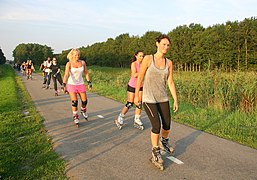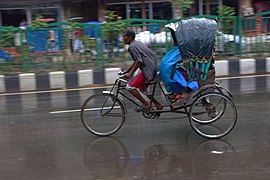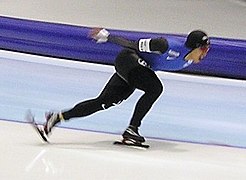
A vehicle is a machine designed for self-propulsion, usually to transport people, cargo, or both. The term "vehicle" typically refers to land vehicles such as human-powered vehicles, animal-powered transports, motor vehicles and railed vehicles, but more broadly also includes cable transport, watercraft, amphibious vehicles, aircraft and space vehicles.
Boardsports are active outdoor sports that are played with any sort of board as the primary equipment. These sports take place on a variety of terrains, from paved flat-ground and snow-covered hills to water and air. Most boardsports are considered action sports or extreme sports, and thus often appeal to youth. Some board sports were marginalized in the past. However, many board sports are gaining mainstream recognition, and with this recognition, they have gotten wider broadcasting, sponsorship and inclusion in institutional sporting events, including the Olympic Games.

Human-powered transport is the transport of person(s) and/or goods (freight) using human muscle power. Unlike animal-powered transport, human-powered transport has existed since time immemorial in the form of walking, running and swimming, as well as small vehicles such as litters, rickshaws, wheelchairs and wheelbarrows. Modern technology has allowed mechanical advantage devices and machines to enhance human-power.

A cart or dray is a vehicle designed for transport, using two wheels and normally pulled by draught animals such as horses, donkeys, mules and oxen, or even smaller animals such as goats or large dogs.

Private transport is the personal or individual use of transportation which are not available for use by the general public, where in theory the user can decide freely on the time and route of transit, using vehicles such as: private car, company car, bicycle, dicycle, self-balancing scooter, motorcycle, scooter, aircraft, boat, snowmobile, carriage, horse, etc., or recreational equipment such as roller skates, inline skates, sailboat, sailplane, skateboard etc.

A single-track vehicle is a vehicle that leaves a single ground track as it moves forward. Single-track vehicles usually have little or no lateral stability when stationary but develop it when moving forward or controlled. In the case of wheeled vehicles, the front and rear wheel usually follow slightly different paths when turning or when out of alignment.

A longboard is a type of skateboard typified by longer decks and wheelbases, larger-diameter and softer (lower-durometer) wheels, and often lower riding height compared to street skateboards, though there is wide variation in the geometry and construction of longboards. Among the earliest types of skateboards, longboards were inspired by surfing, with early longboards drawing from the design of surfboards, resembling and mimicking the motion of riding a surfboard, but adapted to riding on streets in a practice known as sidewalk surfing.

Longboarding is a variation of skateboarding typified by the use of longer boards ("decks") with longer wheelbases and softer wheels. While longboards vary widely in shape and size, compared to street skateboards longboards are designed to be more stable at speed and to have more traction due to larger wheel sizes and softer wheel durometers. While standard street skateboards may typically be between 28 and 34 inches long, longboards can range anywhere from 32 to 50 inches in length. Ride characteristics of longboards generally differ from that of street skateboards due to the use of specialized longboard trucks that have different properties than those typically used with skateboards; while street skateboards use "traditional kingpin" (TKP) trucks that are optimized for tight turning radii, ollie and flip tricks, slides, grinds, and transition skating, longboards are typically paired with "reverse kingpin" (RKP) trucks that are designed for increased stability at higher speeds, more "surfy" carving characteristics, and/or greater ride comfort for commuting over longer distances.

The Trikke is a chainless, pedalless, personal vehicle with a three-wheel frame. The rider stands on two foot platforms above the two rear wheels and steers the vehicle with handlebars attached to the lone front wheel. The cambering system is designed to provide a stable, three-point platform that lets the rider lean into turns while all three wheels remain in contact with the ground. There are several variations of the Trikke, from body-powered fitness machines, to battery-powered transportation and personal mobility vehicles.
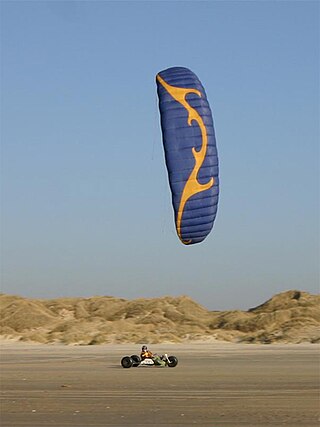
A kite buggy is a light, purpose-built vehicle powered by a traction kite. It is single-seated and has one steerable front wheel and two fixed rear wheels. The driver sits in the seat located in the middle of the vehicle and accelerates and slows down by applying steering manoeuvres in coordination with flying manoeuvres of the kite. This activity is called kite buggying. The speed achieved in kite buggies by skilled drivers can range up to around 110 km/h (70 mph), hence protective clothing, including a safety helmet, is commonly worn.

A kick scooter is a human-powered street vehicle with a handlebar, deck, and wheels propelled by a rider pushing off the ground with their leg. Today the most common scooters are made of aluminum, titanium, and steel. Some kick scooters made for younger children have 3 to 4 wheels and are made of plastic and do not fold. High-performance kickbikes are also made. A company that had once made the Razor Scooters revitalized the design in the mid-nineties and early two-thousands. Three-wheel models where the frame forks into two decks are known as Y scooters or trikkes.

A kickbike is a type of velocipede and is a human-powered street vehicle with a handlebar, deck, and wheels propelled by a rider pushing off the ground. The kickbike often has a large standard size bicycle front wheel and a much smaller rear wheel, which allows for a much faster ride.

A handcycle is a type of human-powered land vehicle powered by the arms rather than the legs, as on a bicycle. Most handcycles are tricycle in form, with two coasting rear wheels and one steerable powered front wheel. Despite usually having three wheels, they are also known as handbikes.
The following outline is provided as an overview of and topical guide to transport:
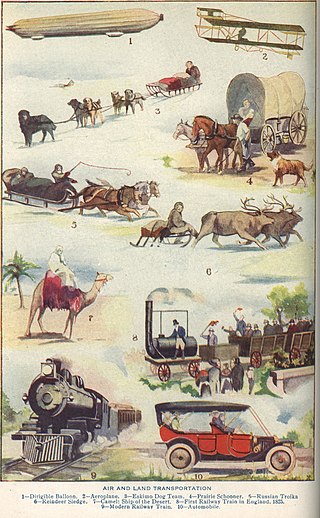
The following outline is provided as an overview of and topical guide to vehicles:
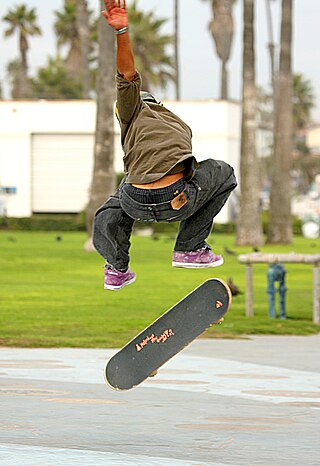
A skateboard is a type of sports equipment used for skateboarding. It is usually made of a specially designed 7–8-ply maple plywood deck and has polyurethane wheels attached to the underside by a pair of skateboarding trucks.

Wind-powered vehicles derive their power from sails, kites or rotors and ride on wheels—which may be linked to a wind-powered rotor—or runners. Whether powered by sail, kite or rotor, these vehicles share a common trait: As the vehicle increases in speed, the advancing airfoil encounters an increasing apparent wind at an angle of attack that is increasingly smaller. At the same time, such vehicles are subject to relatively low forward resistance, compared with traditional sailing craft. As a result, such vehicles are often capable of speeds exceeding that of the wind.

An electric skateboard is a personal transporter based on a skateboard. The speed is usually controlled by a wireless hand-held throttle remote, or rider body weight-shifting between front of the board for forward motion and rear for braking. As for the direction of travel to the right or left, it is adjusted by tilting the board to one side or the other. The classification of electric skateboards and legality of their use on roads or pavements varies between countries.




